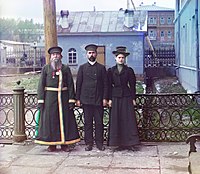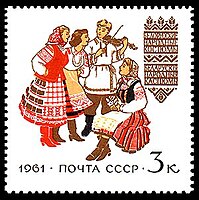The East Slavs are the most populous subgroup of the Slavs. They speak the East Slavic languages, and formed the majority of the population of the medieval state Kievan Rus’, which all three independent East Slavic states (Belarus, Russia, and Ukraine) claim as their cultural ancestor. By the seventeenth-century, the East Slavs eventually evolved into the Belarusians, the Russians, the Rusyns, and the Ukrainians.
History
Sources
Researchers know relatively little about the Eastern Slavs prior to approximately 859 AD when the first events recorded in the Primary Chronicle occurred. The Eastern Slavs of these early times apparently lacked a written language. The few known facts come from archaeological digs, foreign travellers’ accounts of the Rus’ land, and linguistic comparative analyses of Slavic languages.
Very few native Rus’ documents dating before the 11th century (none before the 10th century) have survived. The earliest major manuscript with information on Rus’ history, the Primary Chronicle, dates from the late 11th and early 12th centuries. It lists twelve Slavic tribal unions which, by the 10th century, had settled in the later territory of the Kievan Rus between the Western Bug, the Dniepr and the Black Sea: the Polans, Drevlyans, Dregovichs, Radimichs, Vyatichs, Krivichs, Slovens, Dulebes (later known as Volhynians and Buzhans), White Croats, Severians, Ulichs, and Tivertsi.
Modern East Slavs

Ethnic Russians in former Soviet Union states according to the most recent census
Modern East Slavic peoples and ethnic/subethnic groups include:
- Belarusians
- Litvins
- Poleshuks
- Russians
- Northern and Southern Russians
- Albazinians
- Cossacks
- Doukhobors
- Goryuns
- Kamchadals
- Kamenschiks
- Lipovans
- Polekhs
- Pomors
- Semeiskie
- Siberians
- Starozhily
- Ukrainians
- Slobozhanians
- Volynians
- Podolyans
- Poleshuks
- Halychans
- Zaporozhian Cossacks
- Tavria Zaporozhians
- Black Sea Zaporozhians
- Rusyns
- Boykos
- Hutsuls
- Lemkos
- Pannonian Rusyns
Genetics
According to Y chromosome, mDNA and autosomal marker CCR5de132, gene pool of the East and West Slavs (the Czechs and Slovaks) is identical, which is consistent with the proximity of their languages, demonstrating significant differences from the neighboring Finno-Ugric, Turkic and North Caucasian peoples all the way from west to east; such genetic homogeneity is somewhat unusual for genetics given such a wide dispersal of Slavic populations, especially Russians.[8][9] Together they form the basis of the “East European” gene cluster, which also includes the non-Slavic Hungarians and Aromanians.
Only the Poles and the Northern Russians among the East and West Slavs belong to a different, “Northern European” genetic cluster, along with the Balts, Germanic and Baltic Finnic peoples (Northern Russian populations are very similar to the Balts).
Image gallery
-

Three generations of a Russian family, c. 1910
-

Belarusians in traditional dress
-

Ukrainians in traditional dress
-

Russians in traditional dress of Vologda region
-

Bread and salt greeting ceremony in Vladivostok, Russia
-

Bread and salt greeting ceremony in Kyiv, Ukraine

